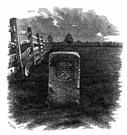The Making of the 50 States: Maryland
Part 2: The Rest of the Story Baltimore, the state's main city, was not founded until 1729. About this time, also, Maryland began a swift journey into the manufacturing sector, with the construction of a series of ironworks. The colony was also a major exporter of tobacco, like its neighbor Virginia, and maker of flour. In 1744, the colony bought from Native Americans the last of what would become the colony of Maryland. This completed what had become a general encirclement of Native American lands by European settlers. Some conflicts between the two peoples were violent, but mostly the Native Americans lost their lands through sheer force of will on the part of the European settlers to grab as much land as they could as quickly as they could. The Maryland Native Americans were not as well organized as those in other colonies and so did not put up as much of a struggle when challenged for ownership fo their land. War between England and France came to Maryland in 1755, when British General Edward Braddock passed through on his way to Fort Duquesne.
In 1775, a large number of Marylanders gathered together and signed the Bush Declaration, at Bush River. This document called for independence from Great Britain. The next year, Maryland mustered soldiers who went to join General George Washington's forces in Boston. They fought in the Battle of Brooklyn and in other northern skirmishes, including White Plains and Harlem Heights. With the coming of the Declaration of Independence came also Maryland's disenfranchisement of the Church of England as the colony's official church. This happened in November 1776 with the Declaration of Rights. The efforts of Marylanders during the Revolutionary War were extensive, among them the organization of troops by Polish cavalry commander Casimir Pulaski. In the last few years of the war, Maryland soldiers fought in many of the major battles in the South, including Camden, Cowpens, and Guilford Courthouse. Annapolis was the capital of the new United States from November 1783 to August 1784. Thus, it was the site of the ratification of the Treaty of Paris, which officially ended the Revolutionary War.
Next page > The Rest of the Story > Page 1, 2 |
|
Social Studies for Kids
copyright 2002–2024
David White



 A property dispute resulted in the formation of the
A property dispute resulted in the formation of the  When Americans became disillusioned with the
When Americans became disillusioned with the 
